Analyzing Global Health Trends with Data
VerifiedAdded on 2020/05/04
|19
|4001
|64
AI Summary
This assignment delves into the analysis of global health trends using statistical techniques. Students examine various factors impacting life expectancy, such as education levels, infrastructure development, and economic indicators. The analysis utilizes datasets from sources like the World Bank to create visualizations (box plots) and apply clustering methods to identify patterns and relationships within the data. The assignment emphasizes the importance of data-driven insights for understanding global health disparities.
Contribute Materials
Your contribution can guide someone’s learning journey. Share your
documents today.
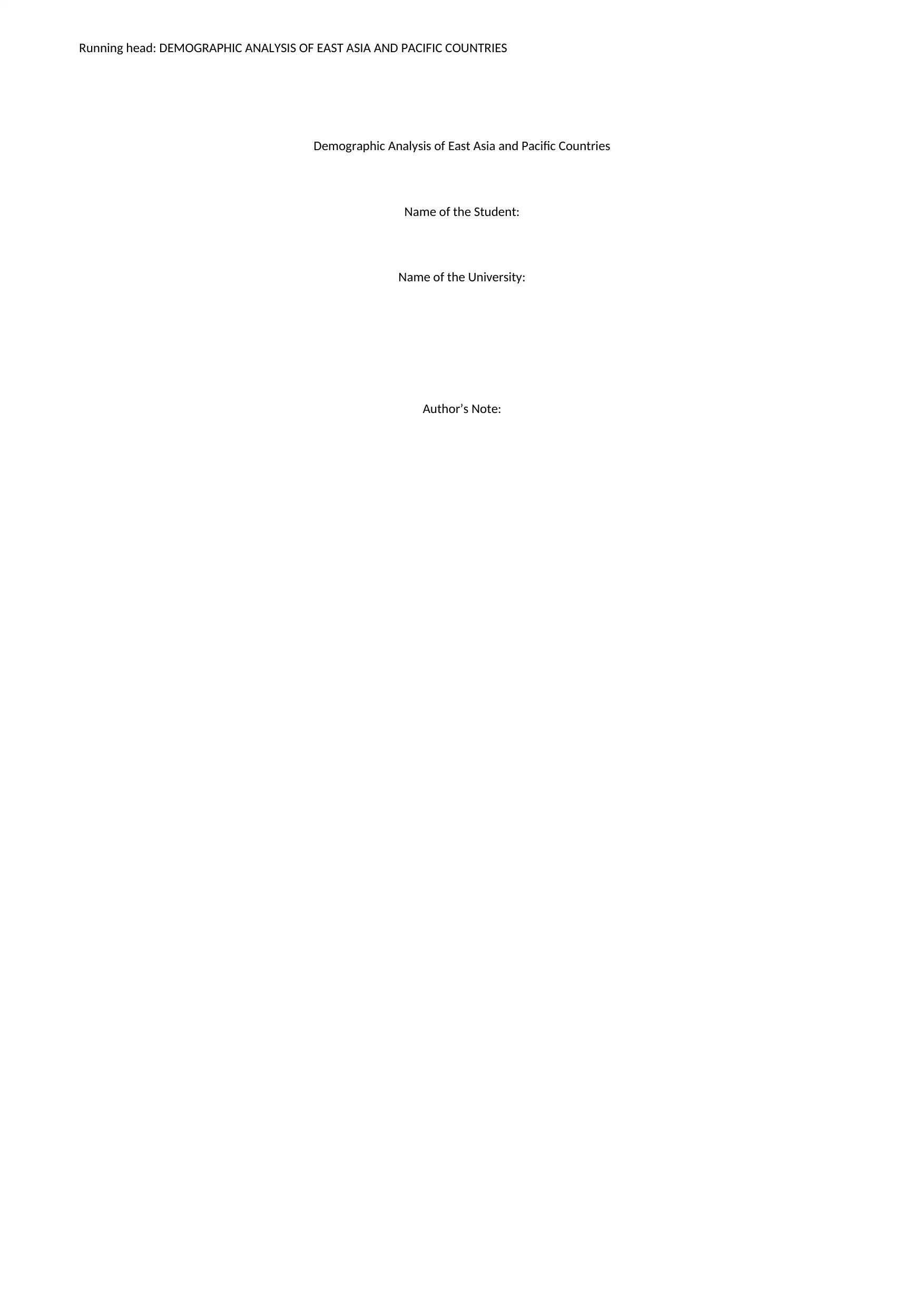
Running head: DEMOGRAPHIC ANALYSIS OF EAST ASIA AND PACIFIC COUNTRIES
Demographic Analysis of East Asia and Pacific Countries
Name of the Student:
Name of the University:
Author’s Note:
Demographic Analysis of East Asia and Pacific Countries
Name of the Student:
Name of the University:
Author’s Note:
Secure Best Marks with AI Grader
Need help grading? Try our AI Grader for instant feedback on your assignments.

DEMOGRAPHIC ANALYSIS OF EAST ASIA AND PACIFIC COUNTRIES
Executive Summary
The World Bank dataset on health and population data gives the different socio-economic factors of the countries of East Asia and pacific
region. The report elaborates the different aspects health infrastructure, socio-economic condition and demographic situation of that
particular country. Report helps to analyze data, decide a conclusion and perform many statistical or mathematical calculations with various
statistical packages. The report is the mirror of demographic overview of East Asian and Pacific counties from 2001 to 2015. More of it, the
report provides the views, thoughts of report writer and Analyst. We provided the theoretical discussions on linear regression and k-means
cluster analysis for clarification of the result. More of all, necessary tables, plots and calculations were supplied for the data interpretation and
conclusions.
Executive Summary
The World Bank dataset on health and population data gives the different socio-economic factors of the countries of East Asia and pacific
region. The report elaborates the different aspects health infrastructure, socio-economic condition and demographic situation of that
particular country. Report helps to analyze data, decide a conclusion and perform many statistical or mathematical calculations with various
statistical packages. The report is the mirror of demographic overview of East Asian and Pacific counties from 2001 to 2015. More of it, the
report provides the views, thoughts of report writer and Analyst. We provided the theoretical discussions on linear regression and k-means
cluster analysis for clarification of the result. More of all, necessary tables, plots and calculations were supplied for the data interpretation and
conclusions.
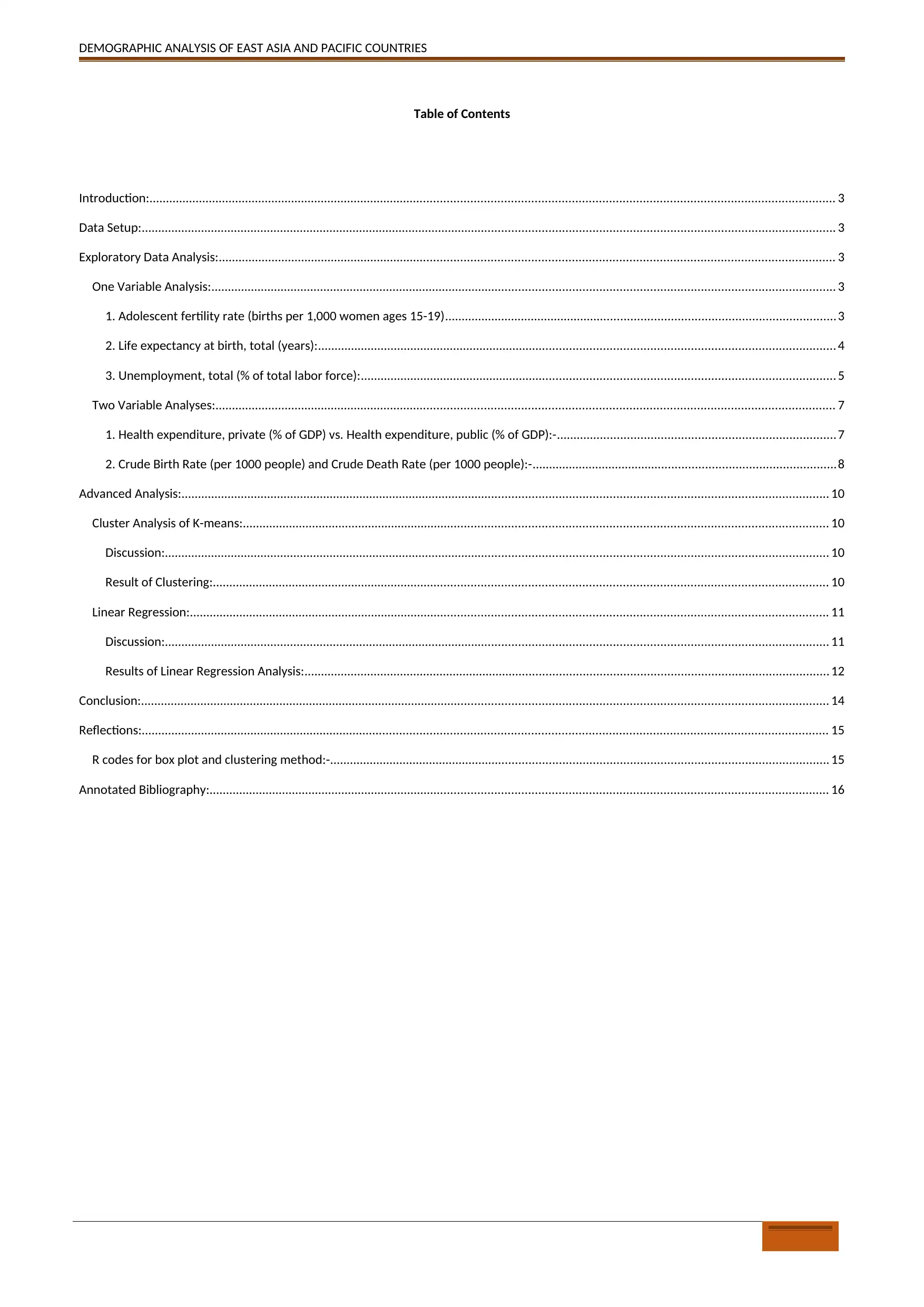
DEMOGRAPHIC ANALYSIS OF EAST ASIA AND PACIFIC COUNTRIES
Table of Contents
Introduction:............................................................................................................................................................................................................. 3
Data Setup:................................................................................................................................................................................................................ 3
Exploratory Data Analysis:........................................................................................................................................................................................ 3
One Variable Analysis:........................................................................................................................................................................................... 3
1. Adolescent fertility rate (births per 1,000 women ages 15-19).....................................................................................................................3
2. Life expectancy at birth, total (years):........................................................................................................................................................... 4
3. Unemployment, total (% of total labor force):.............................................................................................................................................. 5
Two Variable Analyses:......................................................................................................................................................................................... 7
1. Health expenditure, private (% of GDP) vs. Health expenditure, public (% of GDP):-...................................................................................7
2. Crude Birth Rate (per 1000 people) and Crude Death Rate (per 1000 people):-...........................................................................................8
Advanced Analysis:.................................................................................................................................................................................................. 10
Cluster Analysis of K-means:............................................................................................................................................................................... 10
Discussion:....................................................................................................................................................................................................... 10
Result of Clustering:........................................................................................................................................................................................ 10
Linear Regression:............................................................................................................................................................................................... 11
Discussion:....................................................................................................................................................................................................... 11
Results of Linear Regression Analysis:............................................................................................................................................................. 12
Conclusion:.............................................................................................................................................................................................................. 14
Reflections:............................................................................................................................................................................................................. 15
R codes for box plot and clustering method:-..................................................................................................................................................... 15
Annotated Bibliography:......................................................................................................................................................................................... 16
Table of Contents
Introduction:............................................................................................................................................................................................................. 3
Data Setup:................................................................................................................................................................................................................ 3
Exploratory Data Analysis:........................................................................................................................................................................................ 3
One Variable Analysis:........................................................................................................................................................................................... 3
1. Adolescent fertility rate (births per 1,000 women ages 15-19).....................................................................................................................3
2. Life expectancy at birth, total (years):........................................................................................................................................................... 4
3. Unemployment, total (% of total labor force):.............................................................................................................................................. 5
Two Variable Analyses:......................................................................................................................................................................................... 7
1. Health expenditure, private (% of GDP) vs. Health expenditure, public (% of GDP):-...................................................................................7
2. Crude Birth Rate (per 1000 people) and Crude Death Rate (per 1000 people):-...........................................................................................8
Advanced Analysis:.................................................................................................................................................................................................. 10
Cluster Analysis of K-means:............................................................................................................................................................................... 10
Discussion:....................................................................................................................................................................................................... 10
Result of Clustering:........................................................................................................................................................................................ 10
Linear Regression:............................................................................................................................................................................................... 11
Discussion:....................................................................................................................................................................................................... 11
Results of Linear Regression Analysis:............................................................................................................................................................. 12
Conclusion:.............................................................................................................................................................................................................. 14
Reflections:............................................................................................................................................................................................................. 15
R codes for box plot and clustering method:-..................................................................................................................................................... 15
Annotated Bibliography:......................................................................................................................................................................................... 16
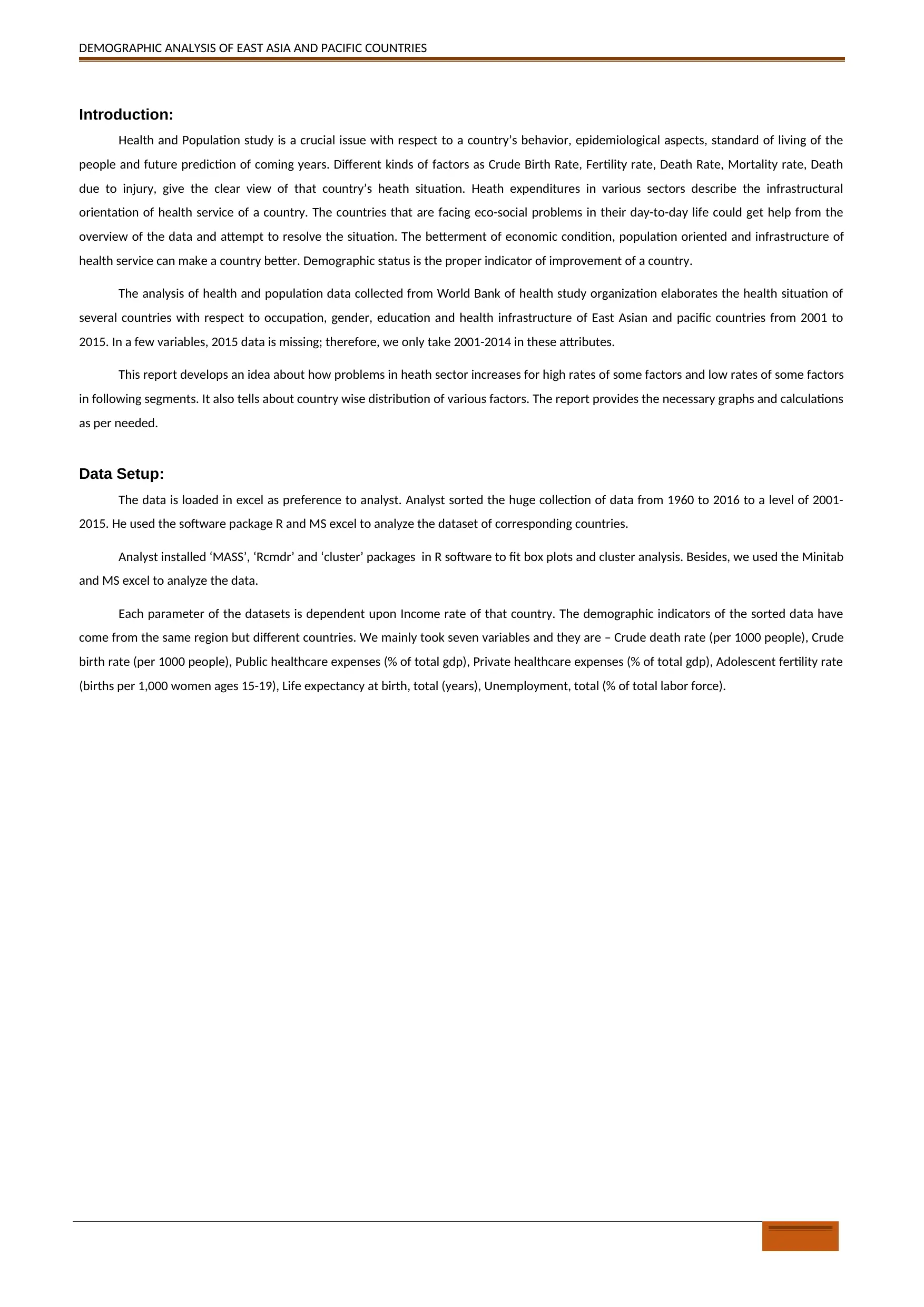
DEMOGRAPHIC ANALYSIS OF EAST ASIA AND PACIFIC COUNTRIES
Introduction:
Health and Population study is a crucial issue with respect to a country’s behavior, epidemiological aspects, standard of living of the
people and future prediction of coming years. Different kinds of factors as Crude Birth Rate, Fertility rate, Death Rate, Mortality rate, Death
due to injury, give the clear view of that country’s heath situation. Heath expenditures in various sectors describe the infrastructural
orientation of health service of a country. The countries that are facing eco-social problems in their day-to-day life could get help from the
overview of the data and attempt to resolve the situation. The betterment of economic condition, population oriented and infrastructure of
health service can make a country better. Demographic status is the proper indicator of improvement of a country.
The analysis of health and population data collected from World Bank of health study organization elaborates the health situation of
several countries with respect to occupation, gender, education and health infrastructure of East Asian and pacific countries from 2001 to
2015. In a few variables, 2015 data is missing; therefore, we only take 2001-2014 in these attributes.
This report develops an idea about how problems in heath sector increases for high rates of some factors and low rates of some factors
in following segments. It also tells about country wise distribution of various factors. The report provides the necessary graphs and calculations
as per needed.
Data Setup:
The data is loaded in excel as preference to analyst. Analyst sorted the huge collection of data from 1960 to 2016 to a level of 2001-
2015. He used the software package R and MS excel to analyze the dataset of corresponding countries.
Analyst installed ‘MASS’, ‘Rcmdr’ and ‘cluster’ packages in R software to fit box plots and cluster analysis. Besides, we used the Minitab
and MS excel to analyze the data.
Each parameter of the datasets is dependent upon Income rate of that country. The demographic indicators of the sorted data have
come from the same region but different countries. We mainly took seven variables and they are – Crude death rate (per 1000 people), Crude
birth rate (per 1000 people), Public healthcare expenses (% of total gdp), Private healthcare expenses (% of total gdp), Adolescent fertility rate
(births per 1,000 women ages 15-19), Life expectancy at birth, total (years), Unemployment, total (% of total labor force).
Introduction:
Health and Population study is a crucial issue with respect to a country’s behavior, epidemiological aspects, standard of living of the
people and future prediction of coming years. Different kinds of factors as Crude Birth Rate, Fertility rate, Death Rate, Mortality rate, Death
due to injury, give the clear view of that country’s heath situation. Heath expenditures in various sectors describe the infrastructural
orientation of health service of a country. The countries that are facing eco-social problems in their day-to-day life could get help from the
overview of the data and attempt to resolve the situation. The betterment of economic condition, population oriented and infrastructure of
health service can make a country better. Demographic status is the proper indicator of improvement of a country.
The analysis of health and population data collected from World Bank of health study organization elaborates the health situation of
several countries with respect to occupation, gender, education and health infrastructure of East Asian and pacific countries from 2001 to
2015. In a few variables, 2015 data is missing; therefore, we only take 2001-2014 in these attributes.
This report develops an idea about how problems in heath sector increases for high rates of some factors and low rates of some factors
in following segments. It also tells about country wise distribution of various factors. The report provides the necessary graphs and calculations
as per needed.
Data Setup:
The data is loaded in excel as preference to analyst. Analyst sorted the huge collection of data from 1960 to 2016 to a level of 2001-
2015. He used the software package R and MS excel to analyze the dataset of corresponding countries.
Analyst installed ‘MASS’, ‘Rcmdr’ and ‘cluster’ packages in R software to fit box plots and cluster analysis. Besides, we used the Minitab
and MS excel to analyze the data.
Each parameter of the datasets is dependent upon Income rate of that country. The demographic indicators of the sorted data have
come from the same region but different countries. We mainly took seven variables and they are – Crude death rate (per 1000 people), Crude
birth rate (per 1000 people), Public healthcare expenses (% of total gdp), Private healthcare expenses (% of total gdp), Adolescent fertility rate
(births per 1,000 women ages 15-19), Life expectancy at birth, total (years), Unemployment, total (% of total labor force).
Secure Best Marks with AI Grader
Need help grading? Try our AI Grader for instant feedback on your assignments.
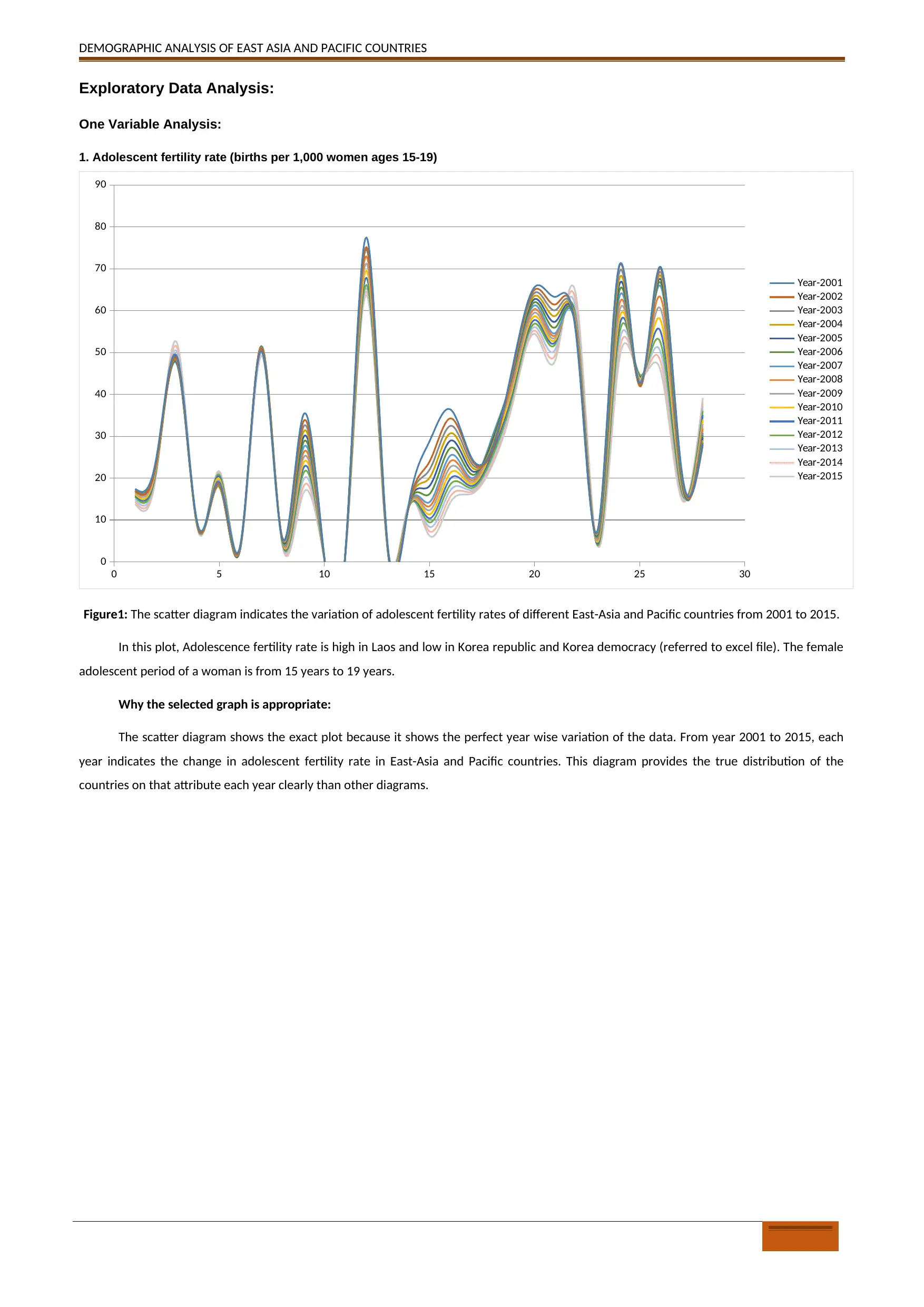
DEMOGRAPHIC ANALYSIS OF EAST ASIA AND PACIFIC COUNTRIES
Exploratory Data Analysis:
One Variable Analysis:
1. Adolescent fertility rate (births per 1,000 women ages 15-19)
0 5 10 15 20 25 30
0
10
20
30
40
50
60
70
80
90
Year-2001
Year-2002
Year-2003
Year-2004
Year-2005
Year-2006
Year-2007
Year-2008
Year-2009
Year-2010
Year-2011
Year-2012
Year-2013
Year-2014
Year-2015
Figure1: The scatter diagram indicates the variation of adolescent fertility rates of different East-Asia and Pacific countries from 2001 to 2015.
In this plot, Adolescence fertility rate is high in Laos and low in Korea republic and Korea democracy (referred to excel file). The female
adolescent period of a woman is from 15 years to 19 years.
Why the selected graph is appropriate:
The scatter diagram shows the exact plot because it shows the perfect year wise variation of the data. From year 2001 to 2015, each
year indicates the change in adolescent fertility rate in East-Asia and Pacific countries. This diagram provides the true distribution of the
countries on that attribute each year clearly than other diagrams.
Exploratory Data Analysis:
One Variable Analysis:
1. Adolescent fertility rate (births per 1,000 women ages 15-19)
0 5 10 15 20 25 30
0
10
20
30
40
50
60
70
80
90
Year-2001
Year-2002
Year-2003
Year-2004
Year-2005
Year-2006
Year-2007
Year-2008
Year-2009
Year-2010
Year-2011
Year-2012
Year-2013
Year-2014
Year-2015
Figure1: The scatter diagram indicates the variation of adolescent fertility rates of different East-Asia and Pacific countries from 2001 to 2015.
In this plot, Adolescence fertility rate is high in Laos and low in Korea republic and Korea democracy (referred to excel file). The female
adolescent period of a woman is from 15 years to 19 years.
Why the selected graph is appropriate:
The scatter diagram shows the exact plot because it shows the perfect year wise variation of the data. From year 2001 to 2015, each
year indicates the change in adolescent fertility rate in East-Asia and Pacific countries. This diagram provides the true distribution of the
countries on that attribute each year clearly than other diagrams.
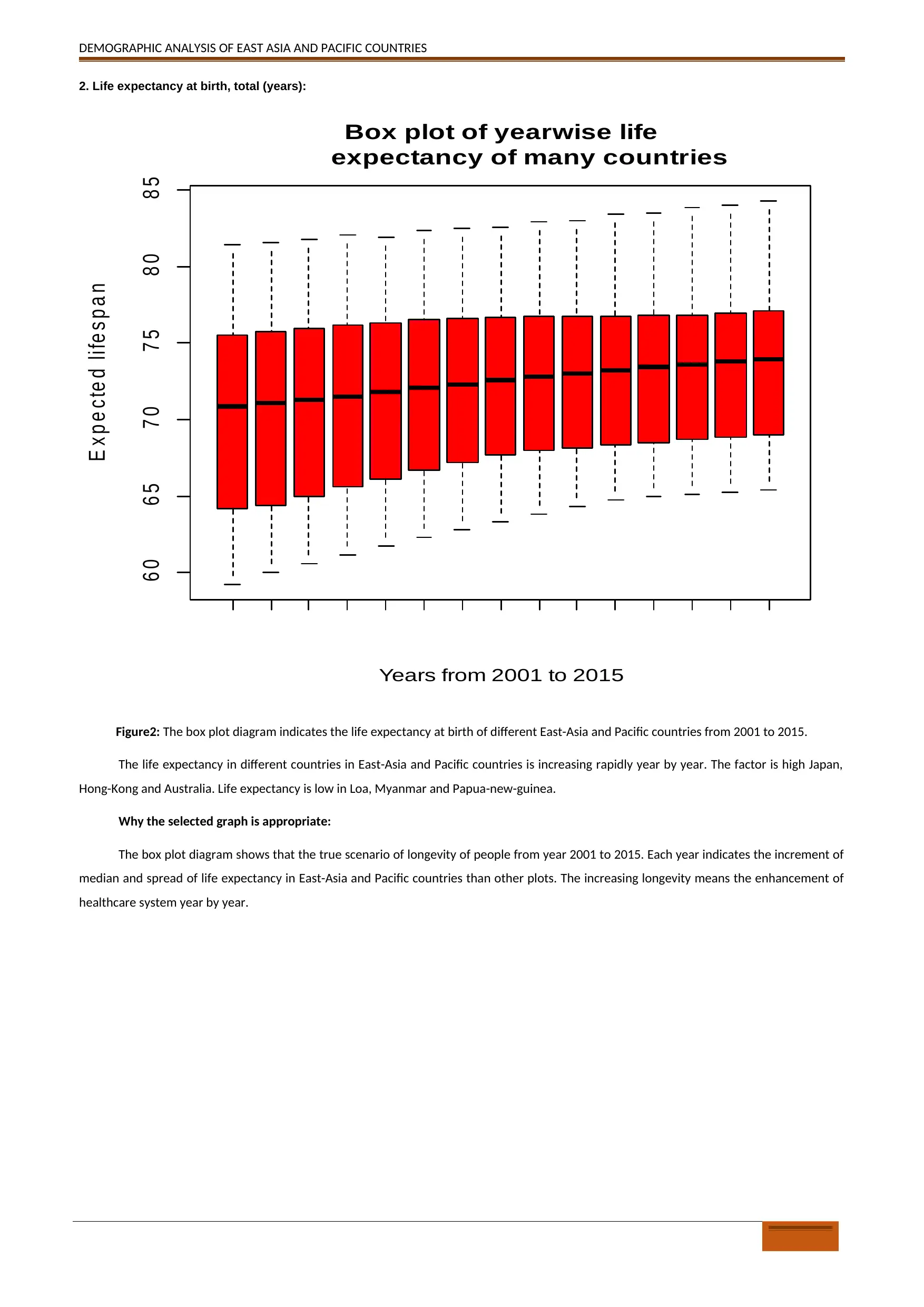
DEMOGRAPHIC ANALYSIS OF EAST ASIA AND PACIFIC COUNTRIES
2. Life expectancy at birth, total (years):
6 0 6 5 7 0 7 5 8 0 8 5
Box plot of yearwise life
expectancy of many countries
Years from 2001 to 2015
E x p e c te d l i fe s p a n
Figure2: The box plot diagram indicates the life expectancy at birth of different East-Asia and Pacific countries from 2001 to 2015.
The life expectancy in different countries in East-Asia and Pacific countries is increasing rapidly year by year. The factor is high Japan,
Hong-Kong and Australia. Life expectancy is low in Loa, Myanmar and Papua-new-guinea.
Why the selected graph is appropriate:
The box plot diagram shows that the true scenario of longevity of people from year 2001 to 2015. Each year indicates the increment of
median and spread of life expectancy in East-Asia and Pacific countries than other plots. The increasing longevity means the enhancement of
healthcare system year by year.
2. Life expectancy at birth, total (years):
6 0 6 5 7 0 7 5 8 0 8 5
Box plot of yearwise life
expectancy of many countries
Years from 2001 to 2015
E x p e c te d l i fe s p a n
Figure2: The box plot diagram indicates the life expectancy at birth of different East-Asia and Pacific countries from 2001 to 2015.
The life expectancy in different countries in East-Asia and Pacific countries is increasing rapidly year by year. The factor is high Japan,
Hong-Kong and Australia. Life expectancy is low in Loa, Myanmar and Papua-new-guinea.
Why the selected graph is appropriate:
The box plot diagram shows that the true scenario of longevity of people from year 2001 to 2015. Each year indicates the increment of
median and spread of life expectancy in East-Asia and Pacific countries than other plots. The increasing longevity means the enhancement of
healthcare system year by year.
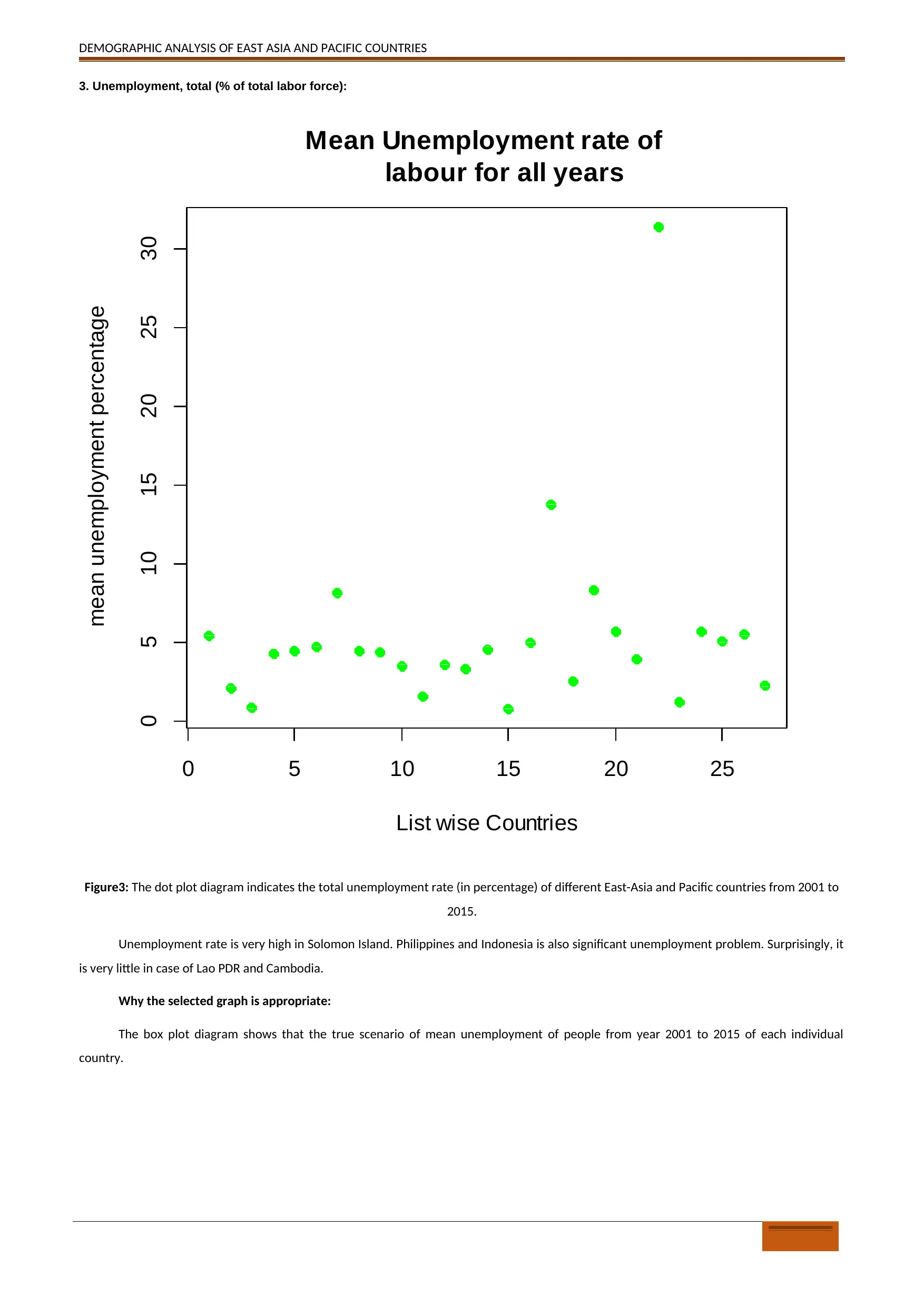
DEMOGRAPHIC ANALYSIS OF EAST ASIA AND PACIFIC COUNTRIES
3. Unemployment, total (% of total labor force):
0 5 10 15 20 25
0 5 10 15 20 25 30
Mean Unemployment rate of
labour for all years
List wise Countries
mean unemployment percentage
Figure3: The dot plot diagram indicates the total unemployment rate (in percentage) of different East-Asia and Pacific countries from 2001 to
2015.
Unemployment rate is very high in Solomon Island. Philippines and Indonesia is also significant unemployment problem. Surprisingly, it
is very little in case of Lao PDR and Cambodia.
Why the selected graph is appropriate:
The box plot diagram shows that the true scenario of mean unemployment of people from year 2001 to 2015 of each individual
country.
3. Unemployment, total (% of total labor force):
0 5 10 15 20 25
0 5 10 15 20 25 30
Mean Unemployment rate of
labour for all years
List wise Countries
mean unemployment percentage
Figure3: The dot plot diagram indicates the total unemployment rate (in percentage) of different East-Asia and Pacific countries from 2001 to
2015.
Unemployment rate is very high in Solomon Island. Philippines and Indonesia is also significant unemployment problem. Surprisingly, it
is very little in case of Lao PDR and Cambodia.
Why the selected graph is appropriate:
The box plot diagram shows that the true scenario of mean unemployment of people from year 2001 to 2015 of each individual
country.
Paraphrase This Document
Need a fresh take? Get an instant paraphrase of this document with our AI Paraphraser
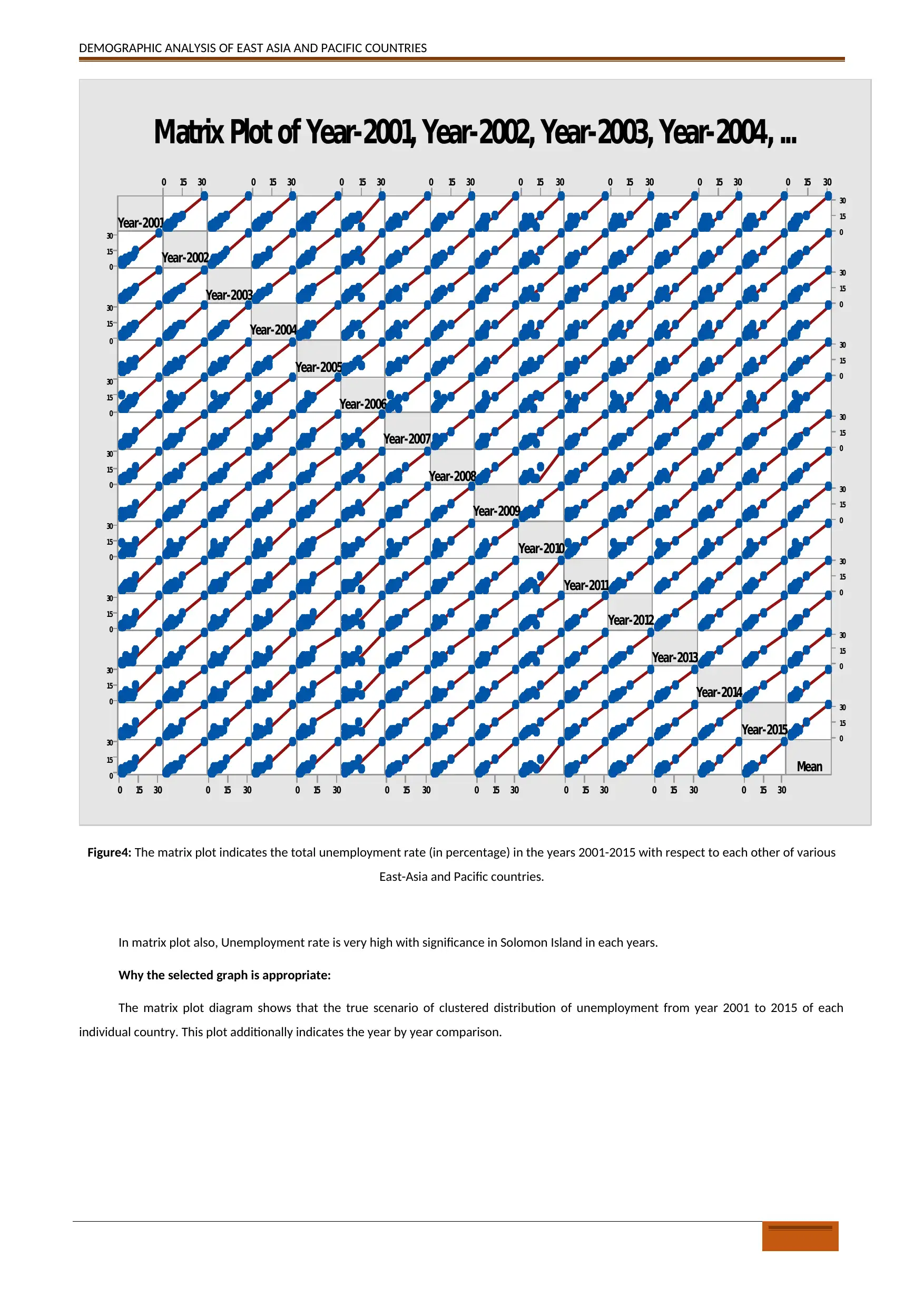
DEMOGRAPHIC ANALYSIS OF EAST ASIA AND PACIFIC COUNTRIES
30150 30150 30150 30150 30150 30150 30150 30150
30
15
0
30
15
0 30
15
030
15
0 30
15
0
30
15
0 30
15
0
30
15
0 30
15
0
30
15
0 30
15
0
30
15
0 30
15
0
30
15
0 30
15
0
30150
30
15
0
30150 30150 30150 30150 30150 30150 30150
Year-2001
Year-2002
Year-2003
Year-2004
Year-2005
Year-2006
Year-2007
Year-2008
Year-2009
Year-2010
Year-2011
Year-2012
Year-2013
Year-2014
Year-2015
Mean
Matrix Plot of Year-2001, Year-2002, Year-2003, Year-2004, ...
Figure4: The matrix plot indicates the total unemployment rate (in percentage) in the years 2001-2015 with respect to each other of various
East-Asia and Pacific countries.
In matrix plot also, Unemployment rate is very high with significance in Solomon Island in each years.
Why the selected graph is appropriate:
The matrix plot diagram shows that the true scenario of clustered distribution of unemployment from year 2001 to 2015 of each
individual country. This plot additionally indicates the year by year comparison.
30150 30150 30150 30150 30150 30150 30150 30150
30
15
0
30
15
0 30
15
030
15
0 30
15
0
30
15
0 30
15
0
30
15
0 30
15
0
30
15
0 30
15
0
30
15
0 30
15
0
30
15
0 30
15
0
30150
30
15
0
30150 30150 30150 30150 30150 30150 30150
Year-2001
Year-2002
Year-2003
Year-2004
Year-2005
Year-2006
Year-2007
Year-2008
Year-2009
Year-2010
Year-2011
Year-2012
Year-2013
Year-2014
Year-2015
Mean
Matrix Plot of Year-2001, Year-2002, Year-2003, Year-2004, ...
Figure4: The matrix plot indicates the total unemployment rate (in percentage) in the years 2001-2015 with respect to each other of various
East-Asia and Pacific countries.
In matrix plot also, Unemployment rate is very high with significance in Solomon Island in each years.
Why the selected graph is appropriate:
The matrix plot diagram shows that the true scenario of clustered distribution of unemployment from year 2001 to 2015 of each
individual country. This plot additionally indicates the year by year comparison.
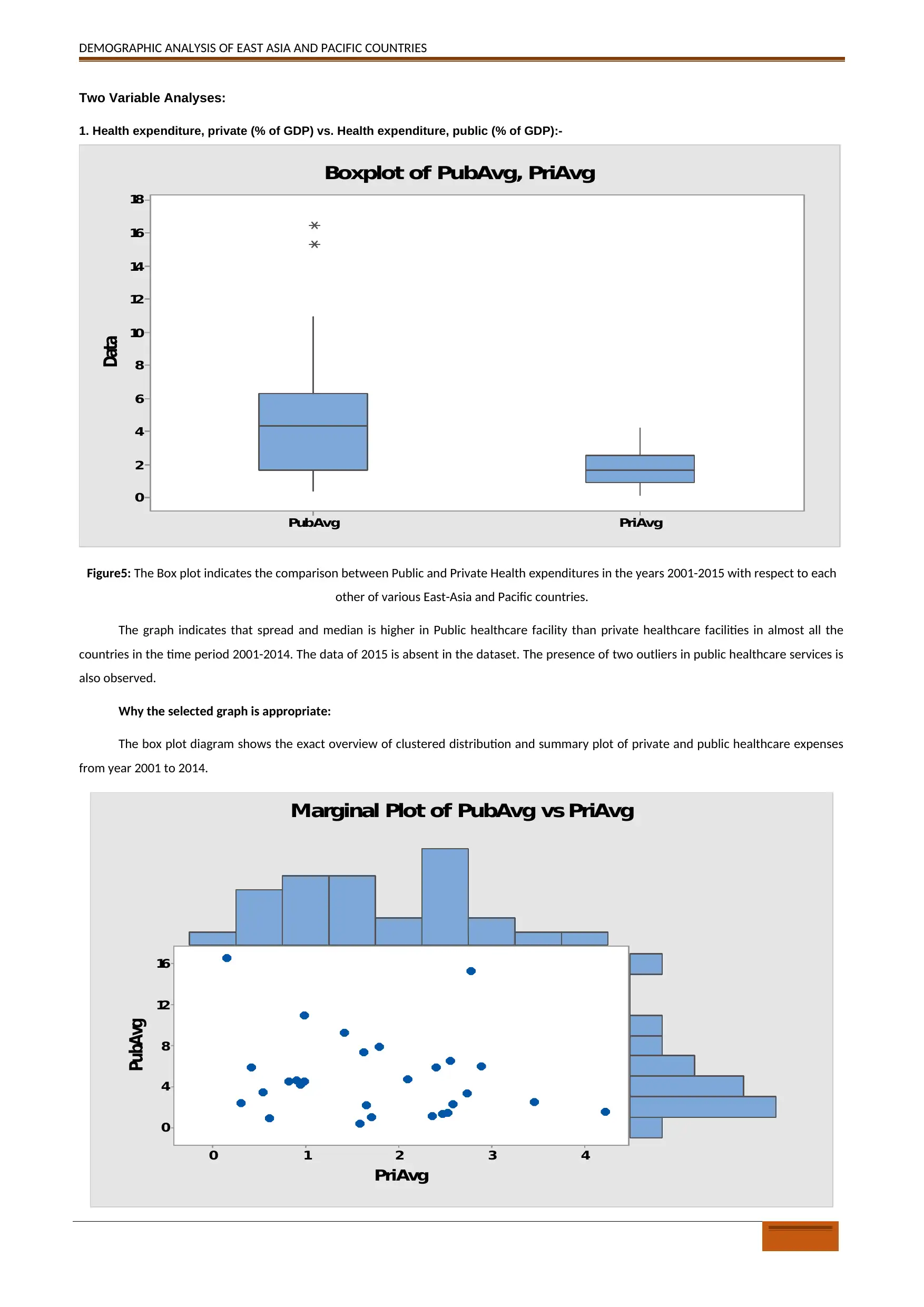
DEMOGRAPHIC ANALYSIS OF EAST ASIA AND PACIFIC COUNTRIES
Two Variable Analyses:
1. Health expenditure, private (% of GDP) vs. Health expenditure, public (% of GDP):-
PriAvgPubAvg
18
16
14
12
10
8
6
4
2
0
Data
Boxplot of PubAvg, PriAvg
Figure5: The Box plot indicates the comparison between Public and Private Health expenditures in the years 2001-2015 with respect to each
other of various East-Asia and Pacific countries.
The graph indicates that spread and median is higher in Public healthcare facility than private healthcare facilities in almost all the
countries in the time period 2001-2014. The data of 2015 is absent in the dataset. The presence of two outliers in public healthcare services is
also observed.
Why the selected graph is appropriate:
The box plot diagram shows the exact overview of clustered distribution and summary plot of private and public healthcare expenses
from year 2001 to 2014.
43210
16
12
8
4
0
PriAvg
PubAvg
Marginal Plot of PubAvg vs PriAvg
Two Variable Analyses:
1. Health expenditure, private (% of GDP) vs. Health expenditure, public (% of GDP):-
PriAvgPubAvg
18
16
14
12
10
8
6
4
2
0
Data
Boxplot of PubAvg, PriAvg
Figure5: The Box plot indicates the comparison between Public and Private Health expenditures in the years 2001-2015 with respect to each
other of various East-Asia and Pacific countries.
The graph indicates that spread and median is higher in Public healthcare facility than private healthcare facilities in almost all the
countries in the time period 2001-2014. The data of 2015 is absent in the dataset. The presence of two outliers in public healthcare services is
also observed.
Why the selected graph is appropriate:
The box plot diagram shows the exact overview of clustered distribution and summary plot of private and public healthcare expenses
from year 2001 to 2014.
43210
16
12
8
4
0
PriAvg
PubAvg
Marginal Plot of PubAvg vs PriAvg
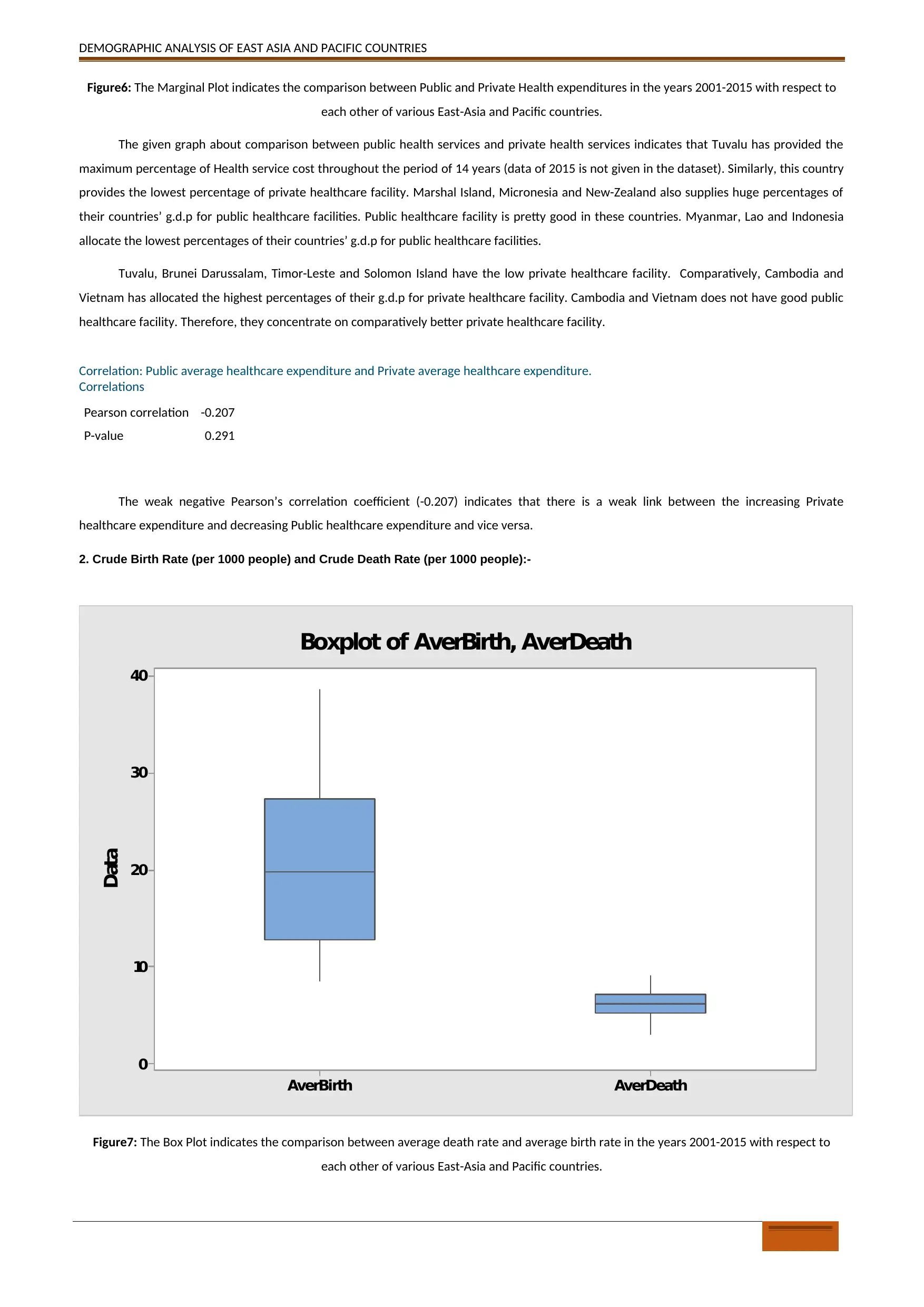
DEMOGRAPHIC ANALYSIS OF EAST ASIA AND PACIFIC COUNTRIES
Figure6: The Marginal Plot indicates the comparison between Public and Private Health expenditures in the years 2001-2015 with respect to
each other of various East-Asia and Pacific countries.
The given graph about comparison between public health services and private health services indicates that Tuvalu has provided the
maximum percentage of Health service cost throughout the period of 14 years (data of 2015 is not given in the dataset). Similarly, this country
provides the lowest percentage of private healthcare facility. Marshal Island, Micronesia and New-Zealand also supplies huge percentages of
their countries’ g.d.p for public healthcare facilities. Public healthcare facility is pretty good in these countries. Myanmar, Lao and Indonesia
allocate the lowest percentages of their countries’ g.d.p for public healthcare facilities.
Tuvalu, Brunei Darussalam, Timor-Leste and Solomon Island have the low private healthcare facility. Comparatively, Cambodia and
Vietnam has allocated the highest percentages of their g.d.p for private healthcare facility. Cambodia and Vietnam does not have good public
healthcare facility. Therefore, they concentrate on comparatively better private healthcare facility.
Correlation: Public average healthcare expenditure and Private average healthcare expenditure.
Correlations
Pearson correlation -0.207
P-value 0.291
The weak negative Pearson’s correlation coefficient (-0.207) indicates that there is a weak link between the increasing Private
healthcare expenditure and decreasing Public healthcare expenditure and vice versa.
2. Crude Birth Rate (per 1000 people) and Crude Death Rate (per 1000 people):-
AverDeathAverBirth
40
30
20
10
0
Data
Boxplot of AverBirth, AverDeath
Figure7: The Box Plot indicates the comparison between average death rate and average birth rate in the years 2001-2015 with respect to
each other of various East-Asia and Pacific countries.
Figure6: The Marginal Plot indicates the comparison between Public and Private Health expenditures in the years 2001-2015 with respect to
each other of various East-Asia and Pacific countries.
The given graph about comparison between public health services and private health services indicates that Tuvalu has provided the
maximum percentage of Health service cost throughout the period of 14 years (data of 2015 is not given in the dataset). Similarly, this country
provides the lowest percentage of private healthcare facility. Marshal Island, Micronesia and New-Zealand also supplies huge percentages of
their countries’ g.d.p for public healthcare facilities. Public healthcare facility is pretty good in these countries. Myanmar, Lao and Indonesia
allocate the lowest percentages of their countries’ g.d.p for public healthcare facilities.
Tuvalu, Brunei Darussalam, Timor-Leste and Solomon Island have the low private healthcare facility. Comparatively, Cambodia and
Vietnam has allocated the highest percentages of their g.d.p for private healthcare facility. Cambodia and Vietnam does not have good public
healthcare facility. Therefore, they concentrate on comparatively better private healthcare facility.
Correlation: Public average healthcare expenditure and Private average healthcare expenditure.
Correlations
Pearson correlation -0.207
P-value 0.291
The weak negative Pearson’s correlation coefficient (-0.207) indicates that there is a weak link between the increasing Private
healthcare expenditure and decreasing Public healthcare expenditure and vice versa.
2. Crude Birth Rate (per 1000 people) and Crude Death Rate (per 1000 people):-
AverDeathAverBirth
40
30
20
10
0
Data
Boxplot of AverBirth, AverDeath
Figure7: The Box Plot indicates the comparison between average death rate and average birth rate in the years 2001-2015 with respect to
each other of various East-Asia and Pacific countries.
Secure Best Marks with AI Grader
Need help grading? Try our AI Grader for instant feedback on your assignments.
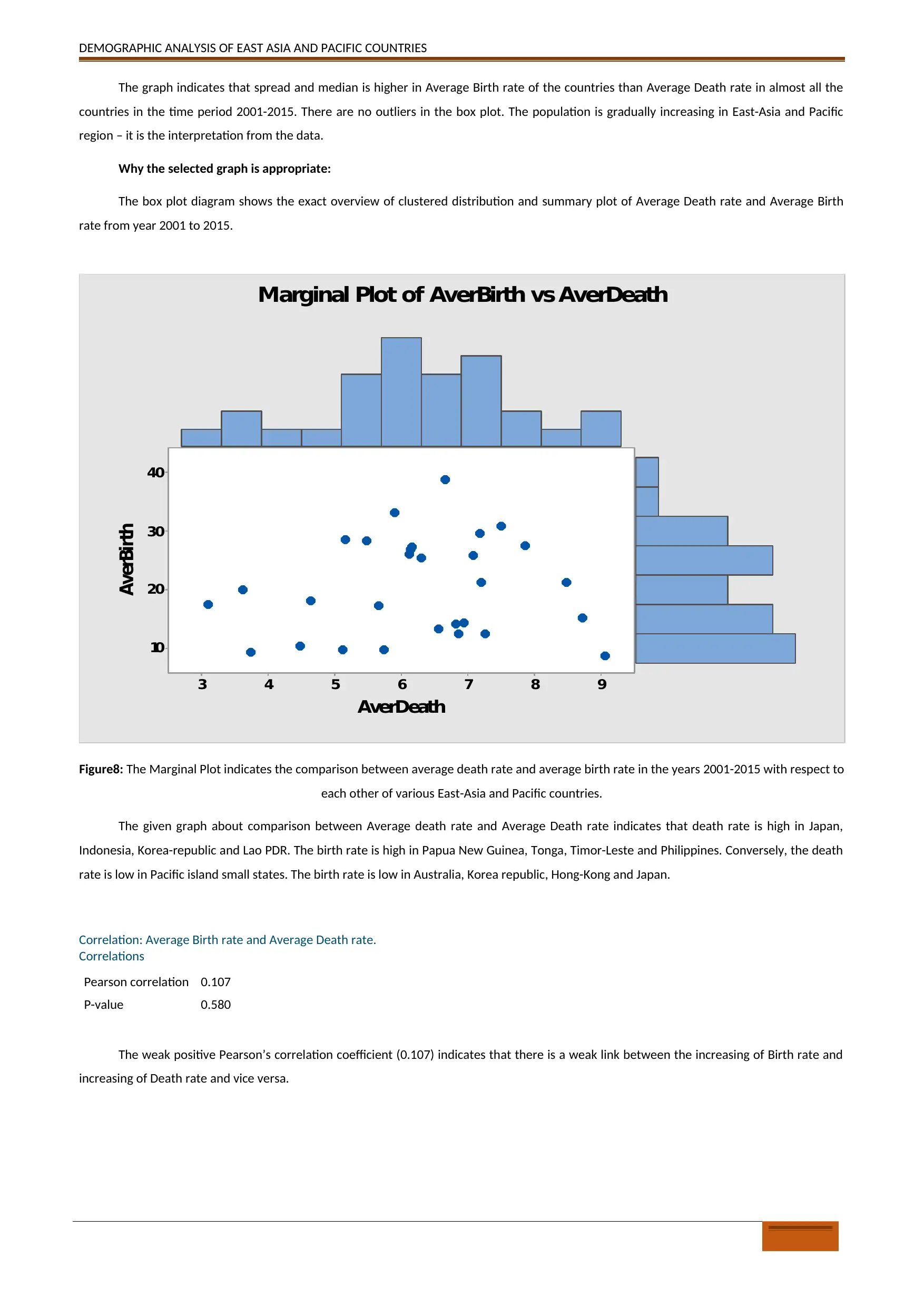
DEMOGRAPHIC ANALYSIS OF EAST ASIA AND PACIFIC COUNTRIES
The graph indicates that spread and median is higher in Average Birth rate of the countries than Average Death rate in almost all the
countries in the time period 2001-2015. There are no outliers in the box plot. The population is gradually increasing in East-Asia and Pacific
region – it is the interpretation from the data.
Why the selected graph is appropriate:
The box plot diagram shows the exact overview of clustered distribution and summary plot of Average Death rate and Average Birth
rate from year 2001 to 2015.
9876543
40
30
20
10
AverDeath
AverBirth
Marginal Plot of AverBirth vs AverDeath
Figure8: The Marginal Plot indicates the comparison between average death rate and average birth rate in the years 2001-2015 with respect to
each other of various East-Asia and Pacific countries.
The given graph about comparison between Average death rate and Average Death rate indicates that death rate is high in Japan,
Indonesia, Korea-republic and Lao PDR. The birth rate is high in Papua New Guinea, Tonga, Timor-Leste and Philippines. Conversely, the death
rate is low in Pacific island small states. The birth rate is low in Australia, Korea republic, Hong-Kong and Japan.
Correlation: Average Birth rate and Average Death rate.
Correlations
Pearson correlation 0.107
P-value 0.580
The weak positive Pearson’s correlation coefficient (0.107) indicates that there is a weak link between the increasing of Birth rate and
increasing of Death rate and vice versa.
The graph indicates that spread and median is higher in Average Birth rate of the countries than Average Death rate in almost all the
countries in the time period 2001-2015. There are no outliers in the box plot. The population is gradually increasing in East-Asia and Pacific
region – it is the interpretation from the data.
Why the selected graph is appropriate:
The box plot diagram shows the exact overview of clustered distribution and summary plot of Average Death rate and Average Birth
rate from year 2001 to 2015.
9876543
40
30
20
10
AverDeath
AverBirth
Marginal Plot of AverBirth vs AverDeath
Figure8: The Marginal Plot indicates the comparison between average death rate and average birth rate in the years 2001-2015 with respect to
each other of various East-Asia and Pacific countries.
The given graph about comparison between Average death rate and Average Death rate indicates that death rate is high in Japan,
Indonesia, Korea-republic and Lao PDR. The birth rate is high in Papua New Guinea, Tonga, Timor-Leste and Philippines. Conversely, the death
rate is low in Pacific island small states. The birth rate is low in Australia, Korea republic, Hong-Kong and Japan.
Correlation: Average Birth rate and Average Death rate.
Correlations
Pearson correlation 0.107
P-value 0.580
The weak positive Pearson’s correlation coefficient (0.107) indicates that there is a weak link between the increasing of Birth rate and
increasing of Death rate and vice versa.

DEMOGRAPHIC ANALYSIS OF EAST ASIA AND PACIFIC COUNTRIES
Advanced Analysis:
Cluster Analysis of K-means:
Discussion:
From n number of samples of datasets if anyone selects k (k<n) number of data for each sample and makes a cluster of p (n/k=p)
numbers, then clustering of multivariate analysis occurs. The centroids of each cluster (of no. k) become the new means. Analysts use
clustering analysis vastly in real life statistical problems and this process implements some algorithms. This k-mean cluster analysis is a relaxed
solution of principal component analysis, Gaussian mixed model and independent component analysis (Saracalli, dogan, dogan 2013).
Cluster analysis helps to take better conclusions on selection of appropriate cluster methods by using variable numbers, subgroup
means, subgroup sizes and variances (Anderberg 2015).
Report maker performed cluster analyses on GNI per capita, Life Expectancy at birth of total population and crude birth rate.
Result of Clustering:
K-means Cluster Analysis: Average Unemployment, Average Adolescent, Average Life Expectancy, Average Public Healthcare Expense, Average
Private Healthcare Expense, Average Death Rate, Average Birth Rate.
Method
Number of clusters 6
Standardized variables No
Final Partition
Number of
observations
Within
cluster sum
of squares
Average
distance
from
centroid
Maximum
distance
from
centroid
Cluster1 3 132.547 6.442 8.401
Cluster2 3 235.501 8.717 10.911
Cluster3 10 2163.267 14.265 19.286
Cluster4 1 0.000 0.000 0.000
Cluster5 4 148.130 6.020 7.365
Cluster6 5 426.701 8.800 14.005
Cluster Centroids
Variable Cluster1 Cluster2 Cluster3 Cluster4 Cluster5 Cluster6
Grand
centroid
AvgUnemployment 4.4574 6.0505 4.5264 31.4133 3.7003 3.7119 5.4447
AvgAdolecence 14.6754 27.4987 54.9794 5.5451 22.5076 3.7710 30.4133
AvgLifeExpect 76.7781 77.1406 68.7966 67.4778 67.9179 77.6392 72.1949
PubAvg 10.6995 3.7412 4.7897 5.8324 5.0465 3.1427 5.1135
PriAvg 2.2144 2.1063 1.6668 0.4172 1.8989 1.9409 1.8211
AverDeath 6.2231 3.7039 6.5331 7.2591 6.8583 6.8529 6.3103
AvgBirth 18.0768 20.4071 21.3621 12.2616 12.2704 17.4095 18.3640
Distances between Cluster Centroids
Cluster1 Cluster2 Cluster3 Cluster4 Cluster5 Cluster6
Cluster1 0.0000 15.0770 41.6442 30.9563 14.3734 13.3501
Cluster2 15.0770 0.0000 28.9368 36.1223 13.9067 24.2489
Cluster3 41.6442 28.9368 0.0000 57.0473 33.7454 52.1504
Cluster4 30.9563 36.1223 57.0473 0.0000 32.5409 30.1660
Cluster5 14.3734 13.9067 33.7454 32.5409 0.0000 21.8083
Cluster6 13.3501 24.2489 52.1504 30.1660 21.8083 0.0000
Advanced Analysis:
Cluster Analysis of K-means:
Discussion:
From n number of samples of datasets if anyone selects k (k<n) number of data for each sample and makes a cluster of p (n/k=p)
numbers, then clustering of multivariate analysis occurs. The centroids of each cluster (of no. k) become the new means. Analysts use
clustering analysis vastly in real life statistical problems and this process implements some algorithms. This k-mean cluster analysis is a relaxed
solution of principal component analysis, Gaussian mixed model and independent component analysis (Saracalli, dogan, dogan 2013).
Cluster analysis helps to take better conclusions on selection of appropriate cluster methods by using variable numbers, subgroup
means, subgroup sizes and variances (Anderberg 2015).
Report maker performed cluster analyses on GNI per capita, Life Expectancy at birth of total population and crude birth rate.
Result of Clustering:
K-means Cluster Analysis: Average Unemployment, Average Adolescent, Average Life Expectancy, Average Public Healthcare Expense, Average
Private Healthcare Expense, Average Death Rate, Average Birth Rate.
Method
Number of clusters 6
Standardized variables No
Final Partition
Number of
observations
Within
cluster sum
of squares
Average
distance
from
centroid
Maximum
distance
from
centroid
Cluster1 3 132.547 6.442 8.401
Cluster2 3 235.501 8.717 10.911
Cluster3 10 2163.267 14.265 19.286
Cluster4 1 0.000 0.000 0.000
Cluster5 4 148.130 6.020 7.365
Cluster6 5 426.701 8.800 14.005
Cluster Centroids
Variable Cluster1 Cluster2 Cluster3 Cluster4 Cluster5 Cluster6
Grand
centroid
AvgUnemployment 4.4574 6.0505 4.5264 31.4133 3.7003 3.7119 5.4447
AvgAdolecence 14.6754 27.4987 54.9794 5.5451 22.5076 3.7710 30.4133
AvgLifeExpect 76.7781 77.1406 68.7966 67.4778 67.9179 77.6392 72.1949
PubAvg 10.6995 3.7412 4.7897 5.8324 5.0465 3.1427 5.1135
PriAvg 2.2144 2.1063 1.6668 0.4172 1.8989 1.9409 1.8211
AverDeath 6.2231 3.7039 6.5331 7.2591 6.8583 6.8529 6.3103
AvgBirth 18.0768 20.4071 21.3621 12.2616 12.2704 17.4095 18.3640
Distances between Cluster Centroids
Cluster1 Cluster2 Cluster3 Cluster4 Cluster5 Cluster6
Cluster1 0.0000 15.0770 41.6442 30.9563 14.3734 13.3501
Cluster2 15.0770 0.0000 28.9368 36.1223 13.9067 24.2489
Cluster3 41.6442 28.9368 0.0000 57.0473 33.7454 52.1504
Cluster4 30.9563 36.1223 57.0473 0.0000 32.5409 30.1660
Cluster5 14.3734 13.9067 33.7454 32.5409 0.0000 21.8083
Cluster6 13.3501 24.2489 52.1504 30.1660 21.8083 0.0000

DEMOGRAPHIC ANALYSIS OF EAST ASIA AND PACIFIC COUNTRIES
2 1
7
3
1 8
1 2
2 4
2 5
2 3
1 9
2 0
9
1 5
1 6
1
5
2
2 6
1 7
1 3
1 4 2 2
1 0
4
1 1
6
8
0 5 0 1 0 0 1 5 0 2 0 0 2 5 0 3 0 0
Cluster Dendrogram
hclust (*, "ward.D")
d1
H e i g h t
Figure9: The hierarchical cluster analysis by complete linkage dendogram (agglomerative hierarchical cluster analysis).
The clustered countries according to the selected attributes are-
1. Singapore (21), Indonesia (7), Cambodia (3), Papua New Guinea (18).
2. Lao (12), Timor-Leste (7), Tonga (25), Thailand (23), Philippines (19), Samoa (20).
3. Korea-Republic (9), Maldives (15), New Zealand (16), Australia (1), East-Asia and Pacific (5), Brunei Darussalam (2), Vietnam (26).
4. Pacific island small states (17), Myanmar (14), Malaysia (13).
5. Solomon Islands (22).
6. Korea-Republic (10), China (4), Lao PDR (11), Japan (8), Hong-Kong china (6).
Linear Regression:
Discussion:
The regression analysis was employed in order to empirically identify whether the Product Line was a statistically important to all other
factors or not. The equation is, Y1=β0 +β1* X1 + …..+ β8 * X8 + μ, where Y1 refers to product line, β0 refers to the constant or the intercept, X1, X2,
…., X8 refers to the all other factors as predictors staring from Age to levels of Fitness, β1, β2….β8 refers to the change of coefficient for the
different predictors, while μ refers to the error term. The regression result shows the goodness of fit for the regression between the Predictors
and response.
Linear regression model is a commonly used generalized form of regression model where the response factor linearly relates with the
parameters of explanatory variables. In linear regression model, the response variable should be continuous and dependent with explanatory
2 1
7
3
1 8
1 2
2 4
2 5
2 3
1 9
2 0
9
1 5
1 6
1
5
2
2 6
1 7
1 3
1 4 2 2
1 0
4
1 1
6
8
0 5 0 1 0 0 1 5 0 2 0 0 2 5 0 3 0 0
Cluster Dendrogram
hclust (*, "ward.D")
d1
H e i g h t
Figure9: The hierarchical cluster analysis by complete linkage dendogram (agglomerative hierarchical cluster analysis).
The clustered countries according to the selected attributes are-
1. Singapore (21), Indonesia (7), Cambodia (3), Papua New Guinea (18).
2. Lao (12), Timor-Leste (7), Tonga (25), Thailand (23), Philippines (19), Samoa (20).
3. Korea-Republic (9), Maldives (15), New Zealand (16), Australia (1), East-Asia and Pacific (5), Brunei Darussalam (2), Vietnam (26).
4. Pacific island small states (17), Myanmar (14), Malaysia (13).
5. Solomon Islands (22).
6. Korea-Republic (10), China (4), Lao PDR (11), Japan (8), Hong-Kong china (6).
Linear Regression:
Discussion:
The regression analysis was employed in order to empirically identify whether the Product Line was a statistically important to all other
factors or not. The equation is, Y1=β0 +β1* X1 + …..+ β8 * X8 + μ, where Y1 refers to product line, β0 refers to the constant or the intercept, X1, X2,
…., X8 refers to the all other factors as predictors staring from Age to levels of Fitness, β1, β2….β8 refers to the change of coefficient for the
different predictors, while μ refers to the error term. The regression result shows the goodness of fit for the regression between the Predictors
and response.
Linear regression model is a commonly used generalized form of regression model where the response factor linearly relates with the
parameters of explanatory variables. In linear regression model, the response variable should be continuous and dependent with explanatory
Paraphrase This Document
Need a fresh take? Get an instant paraphrase of this document with our AI Paraphraser
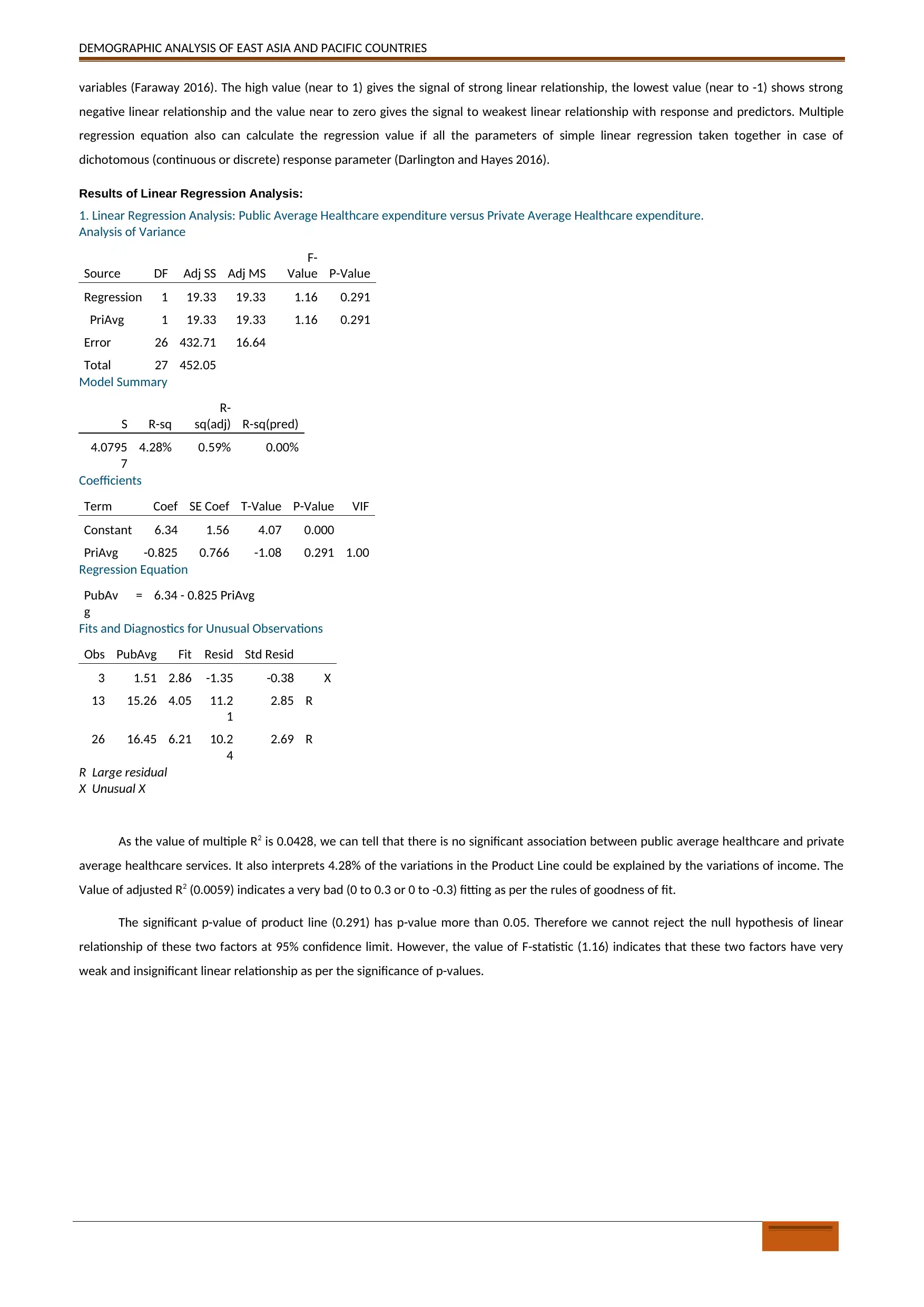
DEMOGRAPHIC ANALYSIS OF EAST ASIA AND PACIFIC COUNTRIES
variables (Faraway 2016). The high value (near to 1) gives the signal of strong linear relationship, the lowest value (near to -1) shows strong
negative linear relationship and the value near to zero gives the signal to weakest linear relationship with response and predictors. Multiple
regression equation also can calculate the regression value if all the parameters of simple linear regression taken together in case of
dichotomous (continuous or discrete) response parameter (Darlington and Hayes 2016).
Results of Linear Regression Analysis:
1. Linear Regression Analysis: Public Average Healthcare expenditure versus Private Average Healthcare expenditure.
Analysis of Variance
Source DF Adj SS Adj MS
F-
Value P-Value
Regression 1 19.33 19.33 1.16 0.291
PriAvg 1 19.33 19.33 1.16 0.291
Error 26 432.71 16.64
Total 27 452.05
Model Summary
S R-sq
R-
sq(adj) R-sq(pred)
4.0795
7
4.28% 0.59% 0.00%
Coefficients
Term Coef SE Coef T-Value P-Value VIF
Constant 6.34 1.56 4.07 0.000
PriAvg -0.825 0.766 -1.08 0.291 1.00
Regression Equation
PubAv
g
= 6.34 - 0.825 PriAvg
Fits and Diagnostics for Unusual Observations
Obs PubAvg Fit Resid Std Resid
3 1.51 2.86 -1.35 -0.38 X
13 15.26 4.05 11.2
1
2.85 R
26 16.45 6.21 10.2
4
2.69 R
R Large residual
X Unusual X
As the value of multiple R2 is 0.0428, we can tell that there is no significant association between public average healthcare and private
average healthcare services. It also interprets 4.28% of the variations in the Product Line could be explained by the variations of income. The
Value of adjusted R2 (0.0059) indicates a very bad (0 to 0.3 or 0 to -0.3) fitting as per the rules of goodness of fit.
The significant p-value of product line (0.291) has p-value more than 0.05. Therefore we cannot reject the null hypothesis of linear
relationship of these two factors at 95% confidence limit. However, the value of F-statistic (1.16) indicates that these two factors have very
weak and insignificant linear relationship as per the significance of p-values.
variables (Faraway 2016). The high value (near to 1) gives the signal of strong linear relationship, the lowest value (near to -1) shows strong
negative linear relationship and the value near to zero gives the signal to weakest linear relationship with response and predictors. Multiple
regression equation also can calculate the regression value if all the parameters of simple linear regression taken together in case of
dichotomous (continuous or discrete) response parameter (Darlington and Hayes 2016).
Results of Linear Regression Analysis:
1. Linear Regression Analysis: Public Average Healthcare expenditure versus Private Average Healthcare expenditure.
Analysis of Variance
Source DF Adj SS Adj MS
F-
Value P-Value
Regression 1 19.33 19.33 1.16 0.291
PriAvg 1 19.33 19.33 1.16 0.291
Error 26 432.71 16.64
Total 27 452.05
Model Summary
S R-sq
R-
sq(adj) R-sq(pred)
4.0795
7
4.28% 0.59% 0.00%
Coefficients
Term Coef SE Coef T-Value P-Value VIF
Constant 6.34 1.56 4.07 0.000
PriAvg -0.825 0.766 -1.08 0.291 1.00
Regression Equation
PubAv
g
= 6.34 - 0.825 PriAvg
Fits and Diagnostics for Unusual Observations
Obs PubAvg Fit Resid Std Resid
3 1.51 2.86 -1.35 -0.38 X
13 15.26 4.05 11.2
1
2.85 R
26 16.45 6.21 10.2
4
2.69 R
R Large residual
X Unusual X
As the value of multiple R2 is 0.0428, we can tell that there is no significant association between public average healthcare and private
average healthcare services. It also interprets 4.28% of the variations in the Product Line could be explained by the variations of income. The
Value of adjusted R2 (0.0059) indicates a very bad (0 to 0.3 or 0 to -0.3) fitting as per the rules of goodness of fit.
The significant p-value of product line (0.291) has p-value more than 0.05. Therefore we cannot reject the null hypothesis of linear
relationship of these two factors at 95% confidence limit. However, the value of F-statistic (1.16) indicates that these two factors have very
weak and insignificant linear relationship as per the significance of p-values.
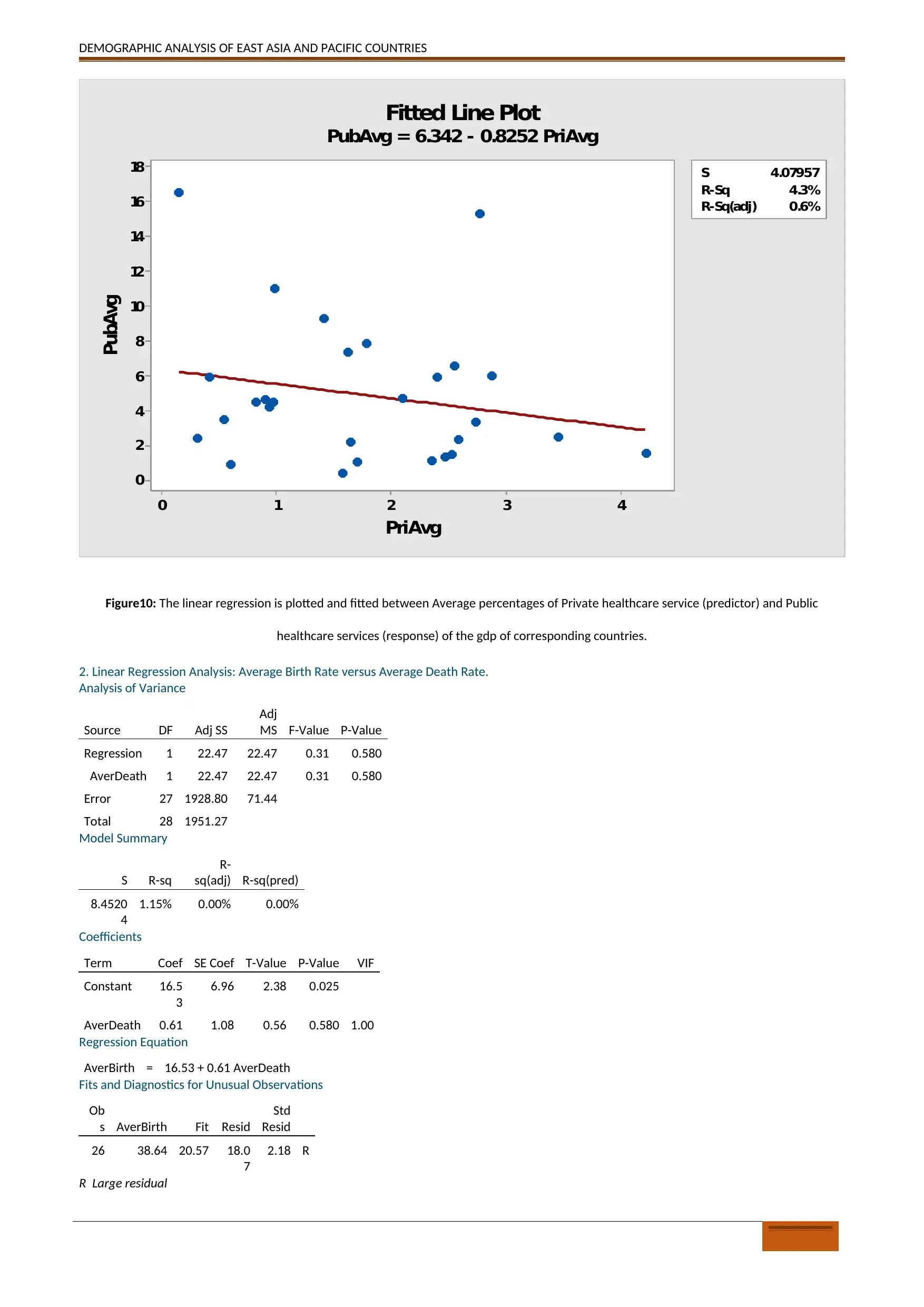
DEMOGRAPHIC ANALYSIS OF EAST ASIA AND PACIFIC COUNTRIES
43210
18
16
14
12
10
8
6
4
2
0
S 4.07957
R-Sq 4.3%
R-Sq(adj) 0.6%
PriAvg
PubAvg
Fitted Line Plot
PubAvg = 6.342 - 0.8252 PriAvg
Figure10: The linear regression is plotted and fitted between Average percentages of Private healthcare service (predictor) and Public
healthcare services (response) of the gdp of corresponding countries.
2. Linear Regression Analysis: Average Birth Rate versus Average Death Rate.
Analysis of Variance
Source DF Adj SS
Adj
MS F-Value P-Value
Regression 1 22.47 22.47 0.31 0.580
AverDeath 1 22.47 22.47 0.31 0.580
Error 27 1928.80 71.44
Total 28 1951.27
Model Summary
S R-sq
R-
sq(adj) R-sq(pred)
8.4520
4
1.15% 0.00% 0.00%
Coefficients
Term Coef SE Coef T-Value P-Value VIF
Constant 16.5
3
6.96 2.38 0.025
AverDeath 0.61 1.08 0.56 0.580 1.00
Regression Equation
AverBirth = 16.53 + 0.61 AverDeath
Fits and Diagnostics for Unusual Observations
Ob
s AverBirth Fit Resid
Std
Resid
26 38.64 20.57 18.0
7
2.18 R
R Large residual
43210
18
16
14
12
10
8
6
4
2
0
S 4.07957
R-Sq 4.3%
R-Sq(adj) 0.6%
PriAvg
PubAvg
Fitted Line Plot
PubAvg = 6.342 - 0.8252 PriAvg
Figure10: The linear regression is plotted and fitted between Average percentages of Private healthcare service (predictor) and Public
healthcare services (response) of the gdp of corresponding countries.
2. Linear Regression Analysis: Average Birth Rate versus Average Death Rate.
Analysis of Variance
Source DF Adj SS
Adj
MS F-Value P-Value
Regression 1 22.47 22.47 0.31 0.580
AverDeath 1 22.47 22.47 0.31 0.580
Error 27 1928.80 71.44
Total 28 1951.27
Model Summary
S R-sq
R-
sq(adj) R-sq(pred)
8.4520
4
1.15% 0.00% 0.00%
Coefficients
Term Coef SE Coef T-Value P-Value VIF
Constant 16.5
3
6.96 2.38 0.025
AverDeath 0.61 1.08 0.56 0.580 1.00
Regression Equation
AverBirth = 16.53 + 0.61 AverDeath
Fits and Diagnostics for Unusual Observations
Ob
s AverBirth Fit Resid
Std
Resid
26 38.64 20.57 18.0
7
2.18 R
R Large residual
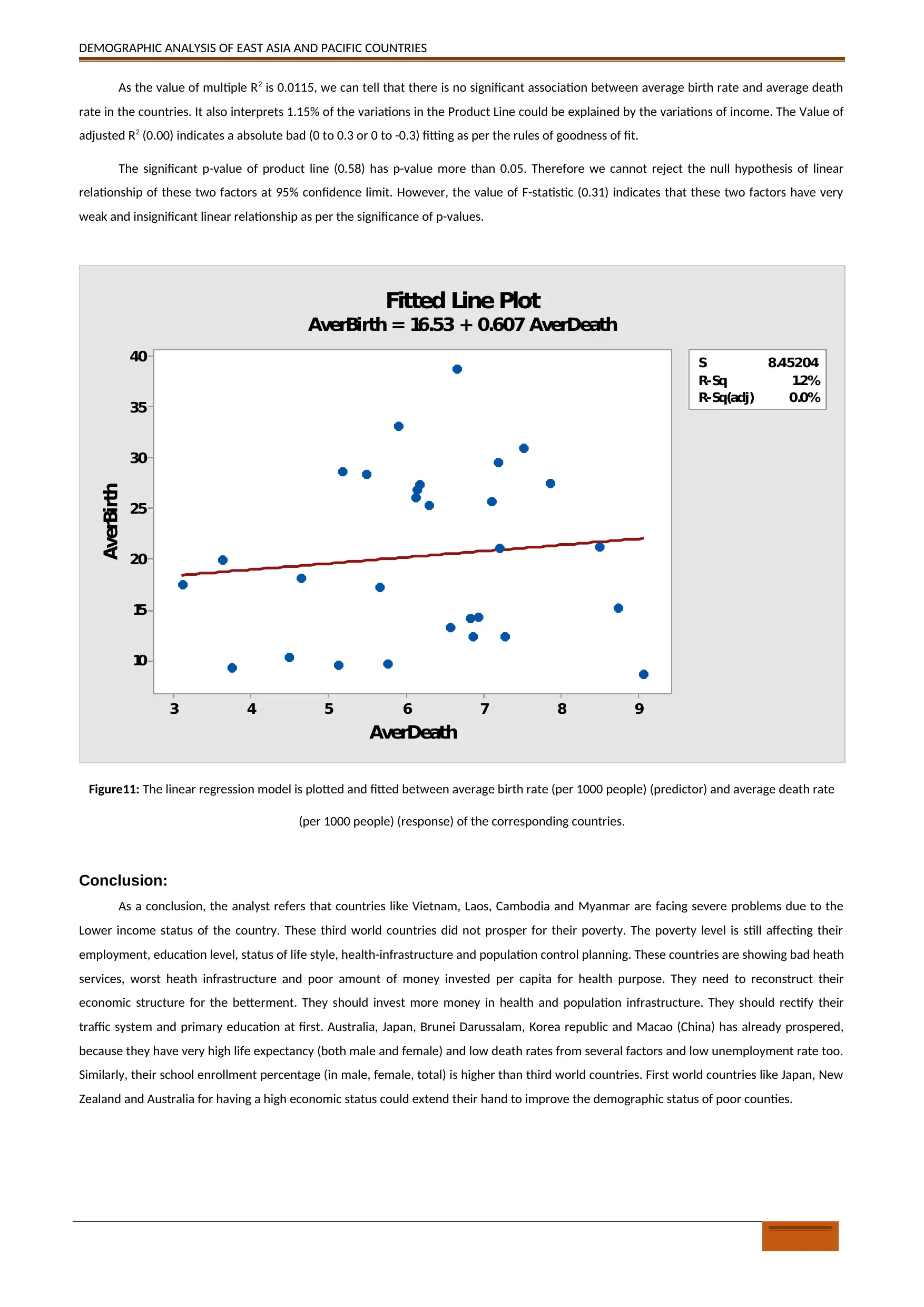
DEMOGRAPHIC ANALYSIS OF EAST ASIA AND PACIFIC COUNTRIES
As the value of multiple R2 is 0.0115, we can tell that there is no significant association between average birth rate and average death
rate in the countries. It also interprets 1.15% of the variations in the Product Line could be explained by the variations of income. The Value of
adjusted R2 (0.00) indicates a absolute bad (0 to 0.3 or 0 to -0.3) fitting as per the rules of goodness of fit.
The significant p-value of product line (0.58) has p-value more than 0.05. Therefore we cannot reject the null hypothesis of linear
relationship of these two factors at 95% confidence limit. However, the value of F-statistic (0.31) indicates that these two factors have very
weak and insignificant linear relationship as per the significance of p-values.
9876543
40
35
30
25
20
15
10
S 8.45204
R-Sq 1.2%
R-Sq(adj) 0.0%
AverDeath
AverBirth
Fitted Line Plot
AverBirth = 16.53 + 0.607 AverDeath
Figure11: The linear regression model is plotted and fitted between average birth rate (per 1000 people) (predictor) and average death rate
(per 1000 people) (response) of the corresponding countries.
Conclusion:
As a conclusion, the analyst refers that countries like Vietnam, Laos, Cambodia and Myanmar are facing severe problems due to the
Lower income status of the country. These third world countries did not prosper for their poverty. The poverty level is still affecting their
employment, education level, status of life style, health-infrastructure and population control planning. These countries are showing bad heath
services, worst heath infrastructure and poor amount of money invested per capita for health purpose. They need to reconstruct their
economic structure for the betterment. They should invest more money in health and population infrastructure. They should rectify their
traffic system and primary education at first. Australia, Japan, Brunei Darussalam, Korea republic and Macao (China) has already prospered,
because they have very high life expectancy (both male and female) and low death rates from several factors and low unemployment rate too.
Similarly, their school enrollment percentage (in male, female, total) is higher than third world countries. First world countries like Japan, New
Zealand and Australia for having a high economic status could extend their hand to improve the demographic status of poor counties.
As the value of multiple R2 is 0.0115, we can tell that there is no significant association between average birth rate and average death
rate in the countries. It also interprets 1.15% of the variations in the Product Line could be explained by the variations of income. The Value of
adjusted R2 (0.00) indicates a absolute bad (0 to 0.3 or 0 to -0.3) fitting as per the rules of goodness of fit.
The significant p-value of product line (0.58) has p-value more than 0.05. Therefore we cannot reject the null hypothesis of linear
relationship of these two factors at 95% confidence limit. However, the value of F-statistic (0.31) indicates that these two factors have very
weak and insignificant linear relationship as per the significance of p-values.
9876543
40
35
30
25
20
15
10
S 8.45204
R-Sq 1.2%
R-Sq(adj) 0.0%
AverDeath
AverBirth
Fitted Line Plot
AverBirth = 16.53 + 0.607 AverDeath
Figure11: The linear regression model is plotted and fitted between average birth rate (per 1000 people) (predictor) and average death rate
(per 1000 people) (response) of the corresponding countries.
Conclusion:
As a conclusion, the analyst refers that countries like Vietnam, Laos, Cambodia and Myanmar are facing severe problems due to the
Lower income status of the country. These third world countries did not prosper for their poverty. The poverty level is still affecting their
employment, education level, status of life style, health-infrastructure and population control planning. These countries are showing bad heath
services, worst heath infrastructure and poor amount of money invested per capita for health purpose. They need to reconstruct their
economic structure for the betterment. They should invest more money in health and population infrastructure. They should rectify their
traffic system and primary education at first. Australia, Japan, Brunei Darussalam, Korea republic and Macao (China) has already prospered,
because they have very high life expectancy (both male and female) and low death rates from several factors and low unemployment rate too.
Similarly, their school enrollment percentage (in male, female, total) is higher than third world countries. First world countries like Japan, New
Zealand and Australia for having a high economic status could extend their hand to improve the demographic status of poor counties.
Secure Best Marks with AI Grader
Need help grading? Try our AI Grader for instant feedback on your assignments.

DEMOGRAPHIC ANALYSIS OF EAST ASIA AND PACIFIC COUNTRIES
Reflections:
R codes for box plot and clustering method:-
The website of World Bank of health did not provide properly arranged data in order to analyst. Analyst faced a serious problem to sort
and analyze the data. The calculation was pretty much time taking. Few calculations were not easily solvable in excel; therefore, analyst took
the help of Minitab and R.
Next time the data analyst might take the help of STATA, SPSS and R (GUI) to shorten up time. He would search for more composed
data and the shortcut processes to analyze the data. Big data analysis should be handled with these factors.
The lesson that the analyst took from the assignment is that he would gain more experience and patience to handle big data like this
one. He should learn more statistical packages like Python, SAS to analyze big data.
Reflections:
R codes for box plot and clustering method:-
The website of World Bank of health did not provide properly arranged data in order to analyst. Analyst faced a serious problem to sort
and analyze the data. The calculation was pretty much time taking. Few calculations were not easily solvable in excel; therefore, analyst took
the help of Minitab and R.
Next time the data analyst might take the help of STATA, SPSS and R (GUI) to shorten up time. He would search for more composed
data and the shortcut processes to analyze the data. Big data analysis should be handled with these factors.
The lesson that the analyst took from the assignment is that he would gain more experience and patience to handle big data like this
one. He should learn more statistical packages like Python, SAS to analyze big data.
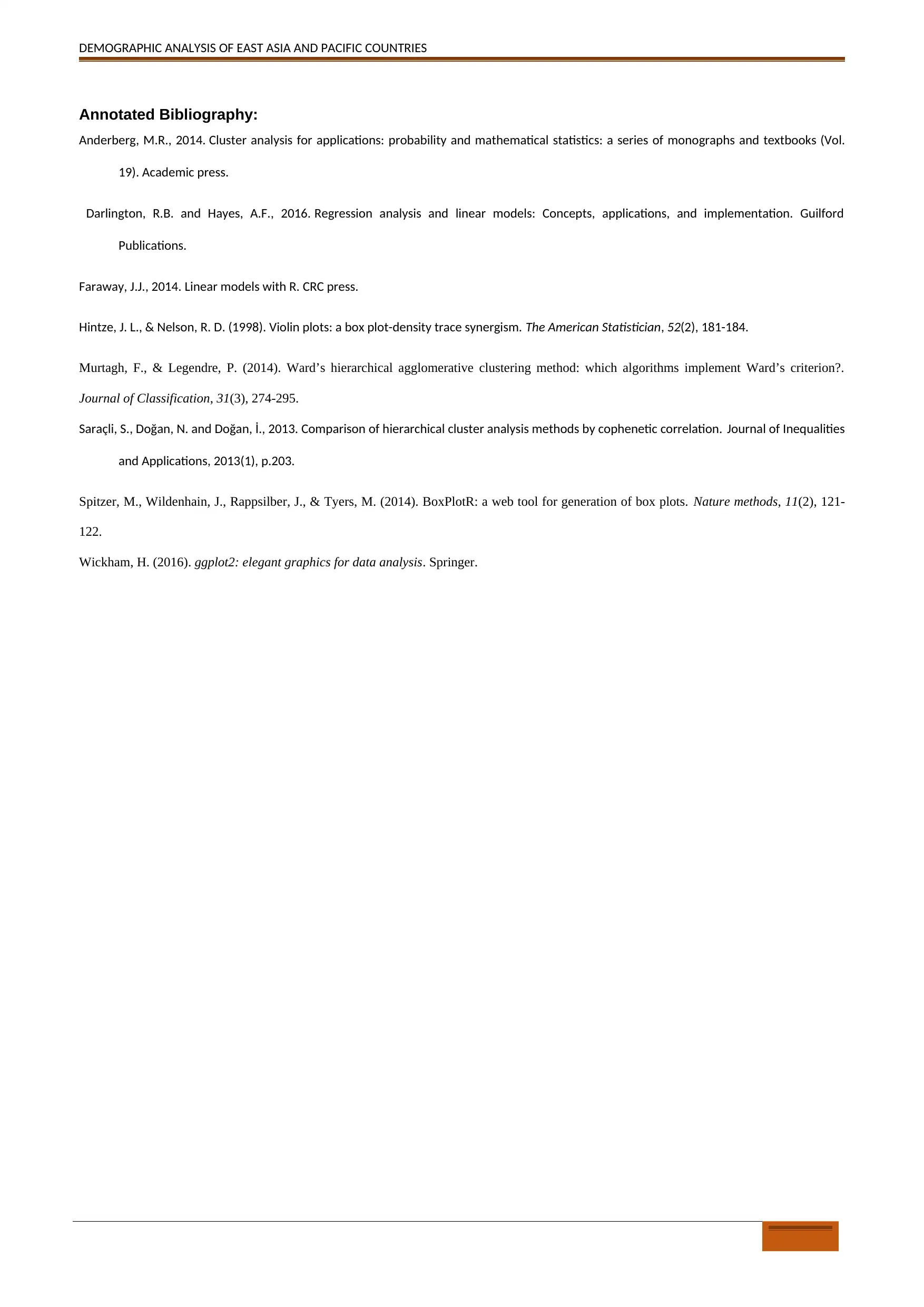
DEMOGRAPHIC ANALYSIS OF EAST ASIA AND PACIFIC COUNTRIES
Annotated Bibliography:
Anderberg, M.R., 2014. Cluster analysis for applications: probability and mathematical statistics: a series of monographs and textbooks (Vol.
19). Academic press.
Darlington, R.B. and Hayes, A.F., 2016. Regression analysis and linear models: Concepts, applications, and implementation. Guilford
Publications.
Faraway, J.J., 2014. Linear models with R. CRC press.
Hintze, J. L., & Nelson, R. D. (1998). Violin plots: a box plot-density trace synergism. The American Statistician, 52(2), 181-184.
Murtagh, F., & Legendre, P. (2014). Ward’s hierarchical agglomerative clustering method: which algorithms implement Ward’s criterion?.
Journal of Classification, 31(3), 274-295.
Saraçli, S., Doğan, N. and Doğan, İ., 2013. Comparison of hierarchical cluster analysis methods by cophenetic correlation. Journal of Inequalities
and Applications, 2013(1), p.203.
Spitzer, M., Wildenhain, J., Rappsilber, J., & Tyers, M. (2014). BoxPlotR: a web tool for generation of box plots. Nature methods, 11(2), 121-
122.
Wickham, H. (2016). ggplot2: elegant graphics for data analysis. Springer.
Annotated Bibliography:
Anderberg, M.R., 2014. Cluster analysis for applications: probability and mathematical statistics: a series of monographs and textbooks (Vol.
19). Academic press.
Darlington, R.B. and Hayes, A.F., 2016. Regression analysis and linear models: Concepts, applications, and implementation. Guilford
Publications.
Faraway, J.J., 2014. Linear models with R. CRC press.
Hintze, J. L., & Nelson, R. D. (1998). Violin plots: a box plot-density trace synergism. The American Statistician, 52(2), 181-184.
Murtagh, F., & Legendre, P. (2014). Ward’s hierarchical agglomerative clustering method: which algorithms implement Ward’s criterion?.
Journal of Classification, 31(3), 274-295.
Saraçli, S., Doğan, N. and Doğan, İ., 2013. Comparison of hierarchical cluster analysis methods by cophenetic correlation. Journal of Inequalities
and Applications, 2013(1), p.203.
Spitzer, M., Wildenhain, J., Rappsilber, J., & Tyers, M. (2014). BoxPlotR: a web tool for generation of box plots. Nature methods, 11(2), 121-
122.
Wickham, H. (2016). ggplot2: elegant graphics for data analysis. Springer.

DEMOGRAPHIC ANALYSIS OF EAST ASIA AND PACIFIC COUNTRIES
1 out of 19
Related Documents
Your All-in-One AI-Powered Toolkit for Academic Success.
+13062052269
info@desklib.com
Available 24*7 on WhatsApp / Email
![[object Object]](/_next/static/media/star-bottom.7253800d.svg)
Unlock your academic potential
© 2024 | Zucol Services PVT LTD | All rights reserved.




